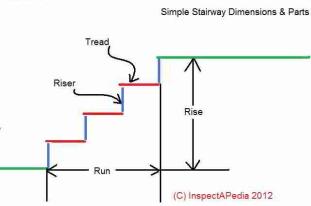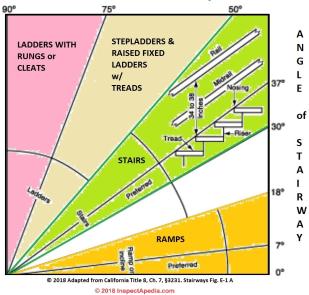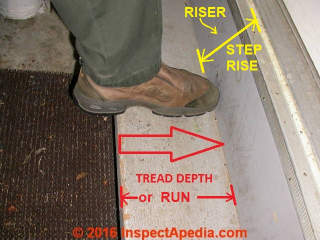Stair Layout for Easy Rise and Run
 Ideal Stair Rising & Run Specifications
Ideal Stair Rising & Run Specifications
Stair Edifice Rules of Thumb & Standard Measurements
- Mail a QUESTION or COMMENT near measuring and calculating to build stairways & low slope or low bending stairways, treads, risers, stairway run, stairway landings & platforms
InspectAPedia tolerates no conflicts of interest. We take no relationship with advertisers, products, or services discussed at this website.
All-time practices for stair layout & design:
Here we describe the recommended measurements for stair building that give a skillful starting betoken from which you tin accommodate the stairs to your specific demand in total stair rise or height and run or length.
We describe how to translate the stair rise and meet a specific number of stair treads and risers that will be uniform and of proper (safe) dimension.
We include a table giving standard access ramp, ladder, and stair specifications for slope, angle, and rise/run measurements for stair treads for various types of stairs, ramps, and ladders.
We also provide Conversion Formulas for Stair Rise/Run, Percent Slope & Bending Degrees Calculations.
We also provide an Commodity Alphabetize for this topic, or you can try the page elevation or lesser SEARCH BOX as a quick style to detect data you demand.
Platonic Stairway Ascension, Run, Gradient, Riser Height Tread Depth
 These notes describe an ideal stairway slope or angle and in a table we requite the stairway as well as access ramp "steepness" expressed as stair or ramp angle, gradient, and as typical pace riser peak and tread depth dimensions.
These notes describe an ideal stairway slope or angle and in a table we requite the stairway as well as access ramp "steepness" expressed as stair or ramp angle, gradient, and as typical pace riser peak and tread depth dimensions.
Past "ideal stairway" we hateful a stair that complies with building codes and recommended stair construction standards and that produce a stair that is comfy to climb or descend.
We also refer readers to a companion article on designing comfortable stairways for people of limited mobility or seniors.
At STAIRWAY Slope or ANGLE & STAIR TREAD SLOPE we depict the maximum as well as recommended stairway angles or slopes and we explain how individual step dimensions (step ascent and step tread depth or "horizontal run") translate into stairway bending.
Analogy: adapted from California Title 8, Ch. 7, §3231. Stairways [PDF] Fig. Eastward, Dominance cited: Section 142.iii, Labor Lawmaking. Reference: Section 142.iii, Labor Lawmaking; and Section 18943(c), Health and Safety Code. Retrieved 2018/07/04, original source: https://www.dir.ca.gov/title8/3231.html
[Click to overstate any image]
Stair Building Rules of Thumb
Our photograph below illustrates stair step tread run or depth and stair step rise or riser height; this particular stair is not a good 1, sporting uneven riser heights and as well-small tread run depth.
 Ideal Stair Dominion of Thumb
Ideal Stair Dominion of Thumb
- Perfect stair (for near users): Ascent = 7", Run = 11"
The sum of one stair or pace tread or "run" and ane pace superlative or "riser" should always exist almost 17" or xviii" in total
- As the step ascent gets shorter the footstep run must go longer
Stair Tread Rules of Thumb
- The sum of two treads plus one riser should add together upwardly to around 28" or 29"
- Stair step or tread "depth" or run - the horizontal walking surface of an individual step. Information technology should be no less than 10". (IRC)
or >= viii 1/iv" to ix" in some codes or circumstandes.
- Stair tread nosing: required, 1" to i 1/2" projection beyond the riser confront
- Stair tread thickness: 1" or greater; tread is supported by the riser.
Stair Riser Rules of Thumb
- Maximum stair step riser height - not more than 7.75" or in some codes <= 7.0" or in Canada <=8.25"
- Minimum stair stride riser meridian: - not less than 4"
- Step riser elevation uniformity - no more 3/eight" variation between successive stride surfaces, or in some codes <= three/16" / four.viii mm.
And because the combination of stair riser pinnacle and stair tread depth or run determines the overall gradient of the stairway, here we include:
- Stairway slope: 7" of rise over 11" of horizontal travel, or a slope of 7/11 (personal preference)
Stairway slope or angle of about 37° which equals approximately a 75% slope
The stairway angle or slope should be betwixt thirty° and fifty°, ideally around 37°
I prefer a 33° stair that is approximately a 66% gradient equally is given past a 7/xi pace ascension/run ratio.
- Step riser slope out of vertical: <= 30 deg measured from horizontal surface of the tread
Stair Handrails & Guardrails Rules of Thumb
- Stair handrail required: 3 risers or more; 36" or more in some jurisdictions.
- Stairway handrailings should be continuous, graspable, and enclosed at ends
- Stair center handrail required: no more than 36" horizontal distance to a handrail on whatever stairway
- Stair guardrail required: iii risers or more; 36" or more in some jurisdictions.
- Stair guard baluster spacing: 4" for solid balusters. 3 1/four" spacing between horizontal cables used in stair guards (three" in some sources)
Stair Landing Platform Rules of Pollex
- Minimum recommended stair landing length: 36" in the direction of travel
- Minimum stair landing width: of the entry or width sufficiently greater than the swing of the door if a wider or slider door is present
- Door shall not swing out over a stairway; a platform or landing is required at same level as the adjacent walking surface
Stair lighting
- Lighting is required over stairs and shall have controls operable from top and bottom of stairway
Articles Detailing Each of these Stair Construction Rules of Thumb
- ADA STAIR & RAIL SPECIFICATIONS
- BALUSTERS, STAIR & RAILING
- ELDERLY & VETERANS HOME SAFETY
- GUARDRAIL on STAIRS, Structure
- HANDRAILS & HANDRAILINGS
- HANDRAILS for Wide STAIRWAYS
- LIGHTING OVER STAIRS & AT EXITS
- Low SLOPE STAIR DIMENSIONS
- PLATFORMS & LANDINGS, ENTRY & STAIR
- STAIR RISER SPECIFICATIONS
- STAIR TREAD DIMENSIONS
- STAIR TREAD - HALTING WALK STUTTER STEP
- STAIR TREAD Olfactory organ SPECIFICATIONS
Find the Total Ascent, Run, & Slope of an Ideal Stairway
Using the numbers suggested higher up in the greenish range of the chart of dimensions for stairs, and looking at the slope or angle of a stairway represented by a single stride (rise & run) nosotros have the following:
- Stride Rise in inches = vii"
- Step Run in inches = 11"
- seven" / eleven" = 0.64 or about a 64% form or percent slope
Let's convert % grade to angle:
To convert a % form to slope we convert the percent slope to a decimal by dividing by 100, so observe the inverse tangent of that value to catechumen to degrees. The changed tangent is also called arctan or Arc Tan.
We had 7" / 11" = 0.64 or about a 64% grade or slope
64% grade / 100 = 0.64
Using any online or textbook trigonometry tables we look upwardly the arctan value of 0.64 (equally that's easier than re-learning the trigonometry to summate information technology).
Arctan (0.64) = 32.half-dozen deg stair angle, or almost 33 degree angle or gradient for our platonic stair
Scout out: for seniors or others of express mobility, other stair dimensions are ideal.
Encounter STAIR DESIGN for SENIORS
Notice the ascension and run of a 37° sloped stairway or a 37° angled stair

[Click to enlarge any epitome]
If stairs are built with a 37° stairway gradient, what would be the stride rising (Rise-X) if we apply an 11-inch deep stair tread?
37° slope converts to 75.3 % or in decimal form a slope of 0.7535
Tangent or "Tan" is the reverse of Arctan.
Ascent-10 / 11 = 0.7535
Using simple algebra we re-arrange the formula to a higher place to read
Rise-10 = 0.7535 x 11
Rise-X = 8.2" - too big
Lookout man out: at STAIR RISER SPECIFICATIONS and at STAIR DIMENSIONS, WIDTH, HEIGHT you'll read that stair risers should be 7 inches (178 mm) maximum and 4 inches (102 mm) minimum.
We would demand change the stair tread depth to make a 37° slope stair that has an acceptable 7-inch riser height.
vii" Riser Height / Tread-Depth-Y = 0.7535 = 37° slope
Over again using Mrs. Revere'due south elementary school algebra instructions, nosotros tin re-write the formula as
7" Riser Top = 0.7535 ten Tread-Depth-Y
Tread-Depth-Y = 7" Riser Peak / 0.7535
Common Ramp, Stair & Ladder Bending, Slope, Rise / Run Dimensions | ||
| Bending in Degrees° | Gradient % | Example Rising / Run |
| Ramp Slope | ||
| 0 - flat | 0 | 0 / 12 |
| 7° | 12% | 1.44 / 12 |
| 18° | 32% | 3.84 / 12 |
| Stairway Slope | ||
| 30° | 58% | vi.iv / 11 |
| 32.6° | 64% | half dozen.4 / 10 or 7 / 11 |
| 37° | 75% | half dozen.75 / 9 or 7.5 / 10 |
| 45° | 100% | 7 / 7 or seven.5 / seven.5 |
| 50° | 102% | vii.14 / 7 |
| Fixed Ladder | ||
| 50° | 102% | |
| 75° | 373% | |
| Runged Ladder | ||
| 75° | 373% | |
| 90° | N/A | |
Notes to the table in a higher place
OPINION: amongst common stair dimensions, angles, or slopes, we prefer the 32.half-dozen° angle or 64% rise stairway built using stair treads that are 11" deep and stair risers of 7" in height.
Going to a lower rise tin as well work every bit yous'll see in the tabular array in a higher place, simply at stair steps with higher ascension, to go on the stairway within adequate overall angle the tread depths become more shallow, making the stairs more-difficult to use.
Conversion Formulas for Stair Ascent/Run, Per centum Slope & Angle Degrees Calculations

How to Convert Full Stair or Private Stride Rise & Run to Percent Slope
Rise / Run = Decimal gradient
Decimal gradient 10 100 = % Slope.
or
(Rising / Run ) ten 100 = % Slope
Eg: 7" ascension / eleven" run = 0.636 decimal gradient
(0.636 x 100) decimal slope = 64% slope
How to Convert Percent of Slope to Bending° or Degrees of Slope
Degrees of Slope = [ArcTan (% Slope / 100)]
Eg: [ArcTan (64% slope / 100)] = [ArcTan .64] = 32.6° slope
How to Convert Degrees of Slope to Percentage Slope
Percentage Slope = [ Tan ( Degrees of Slope ) ] 10 100
Eg: [Tan 32.6° Slope] ten 100 = 63.9 or about 64% gradient
Note: a tangent is a ratio of 2 sides of a triangle - in our example the stair triangle shown above.
Tan (θ) = contrary / adjacent
Percent slope = Bending in degrees / 360 x 100
Note: that divisor of 360 is the number of degrees in a total circle.
How to Catechumen Stair Angle to Stair Rise & Run or Pace Ascension & Tread Depth Dimensions
Encounter BUILD a STAIR to a SPECIFIC ANGLE or SLOPE
and Summate stair tread depth or riser pinnacle from stairway slope in degrees
...
Continue reading at STAIR ANGLE & Slope or select a topic from the closely-related articles below, or come across the complete ARTICLE INDEX.
Or come across these
Recommended Articles
- FRAMING TRIANGLES & CALCULATIONS
- ROOF Gradient CALCULATIONS explanation of the mathematics of computing stair or roof slope, angle, pitch, ascent, run, etc. as well equally examples of using trigonometric functions such as tangent
- Slip TRIP & Autumn HAZARD List, STAIRS
- STAIR BUILDING RULES of THUMB
- STAIR Construction Ideal DIMENSIONS
- STAIR Structure, LOW Angle Slope
- STAIR CONSTRUCTION, SPECIFIC ANGLE or SLOPE
- STAIR CONSTRUCTION, SPECIFIC TOTAL Rise & RUN
- STAIR DESIGNS for UNEVEN / SLOPED SURFACES
- STAIR RISE & RUN CALCULATIONS
- STAIR DIMENSIONS, WIDTH, HEIGHT
- STAIR Bending & SLOPE
- STAIR Design for SENIORS
- STAIR DESIGNS for UNEVEN / SLOPED SURFACES
- STAIR CONSTRUCTION IDEAL DIMENSIONS
- STAIR CONSTRUCTION, LOW ANGLE Gradient
- STAIR CONSTRUCTION, SPECIFIC ANGLE or Gradient
- STAIR Structure, SPECIFIC TOTAL RISE & RUN
- STAIR HEADROOM
- STAIR PLATFORMS & LANDINGS
- STAIR RISE & RUN CALCULATIONS
- STAIR RISER SPECIFICATIONS
- STAIR STRINGER SPECIFICATIONS
- STAIR STRINGER DEFECTS
- STAIR TREAD DIMENSIONS
- STAIR TREAD - HALTING WALK STUTTER Pace
- STAIR TREAD NOSE SPECIFICATIONS
- STAIR USER FOOT & HAND PLACEMENT
- TANGENTS Tabular array
Suggested citation for this web page
STAIR Structure Platonic DIMENSIONS at AuditApedia.com - online encyclopedia of building & environmental inspection, testing, diagnosis, repair, & problem prevention advice.
Or see this
Index to RELATED Manufactures: Commodity INDEX to STAIRS RAILINGS LANDINGS RAMPS
Or use the SEARCH BOX found below to Inquire a Question or Search InspectApedia
...
Inquire a Question or Search InspectApedia
Try the search box just beneath, or if yous prefer, post a question or comment in the Comments box below and we will respond promptly.
Search the InspectApedia website
Note: appearance of your Comment beneath may be delayed: if your annotate contains an prototype, web link, or text that looks to the software as if it might be a web link, your posting will appear after it has been approved by a moderator. Apologies for the delay. Our Annotate Box is provided by Countable Spider web Productions countable.ca
Technical Reviewers & References
Click to Testify or Hide Citations & References
Source: https://inspectapedia.com/Stairs/Ideal-Stair-Design-Specifications.php